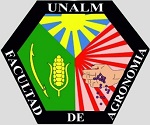Gamma radiosensitivity of coffee (Coffea arabica L. var. typica)
DOI:
https://doi.org/10.21704/pja.v3i2.1317Keywords:
Coffee, radiosensitivity, gamma ray, germination, survival, morphology.Abstract
The effects of gamma radiation on the germination, survival, and morphological damage in characteristics of the M1 generation of coffee (Coffea arabica L. var. typica) plants was evaluated using seeds collected from Santa Teresa and Chaupimayo, Peru. Under net house, the percentage of germination was 68%, 35%, 10%, and 0% for the Santa Teresa seeds and 75%, 49%, 17% and 0% for the Chaupimayo seeds with irradiation treatments of 0, 50, 100 and 150 Gy, respectively, whereas under laboratory conditions, germination levels were between 70% and 94% across all treatments. The survival rate also decreased with increasing radiation levels, with values of 45%, 32%, 28%, and 10% in the laboratory and 29%, 9%, 6%, and 0% in the net house for the Santa Teresa seeds and 58%, 45%, 38%, and 8% in the laboratory and 42%, 15%, 7%, and 0% in the net house for the Chaupimayo seeds with irradiation treatments of 0, 50, 100, and 150 Gy, respectively. Morphological changes were observed in the plants that survived irradiation at a dose of 100 Gy in terms of the leaf shape, leaf apex shape, young leaf color, plant height, stem diameter, number of leaves per plant, leaf length, leaf width, and distance from the cotyledon to the first node.Downloads
References
Al-Salhi, M., Ghannam, M., Al-Ayed, M., El-Kameesy, S., & Roshdy, S. (2004). Effect of gamma irradiation on the biophysical and morphological properties of corn. Nahrung, 48(2), 95–98
Alvarado, A.G. (2005). Evolution of Hemileia vastatrix virulence in Colombia. In: L. Zambolim, E. Zambolim, V. Varzea (Eds.). Durable Resistance to Coffee Leaf Rust. (pp. 99–115).Viçosa MG, Brazil. Editora UFV.
Bacon, C. (2004). Confronting the coffee crisis: Can fair trade, organic, and specialty coffees reduce smallscale farmer vulnerability in northern Nicaragua?. World Development, 33(3), 497–511.
Canul, K., García-Pérez, F., Campos-Bravo, E., BarriosGómez, E., De La Cruz-Torres, E., García-Andrade, Osuna-Canizalez, F., & Ramírez S. (2012). Efecto de la irradiación sobre nochebuena–silvestre (Euphorbia pulcherrima Willd. ex Klotzsch) en Morelos. Revista Mexicana de Ciencias Agrícolas, 3(8), 1495–1507.
Carvalho, C.R., Fernandes, R.C., Carvalho, G.M.A., Barreto, R.W., & Evans, H.C. (2011). Cryptosexuality and the genetic diversity paradox in coffee rust, Hemileia vastatrix. Plos One, 6(11), e26387.
Castro-Caicedo, B.L., Cortina-Guerrero, H.A., Roux, J., & Wingfield, M.J. (2013). New coffee (Coffea arabica) genotypes derived from Coffea canephora exhibiting high levels of resistance to leaf rust and Ceratocystis canker. Tropical Plant Pathology, 38, 485–494.
Cheema A.A. & Atta, B. (2003). Radiosensitivity studies in Basmati ruce. Pakistan Journal of Botany 35(2): 197–207.
Hameed, A., Mahmud, T., Atta, B., Haq, M.A., & Sayed, H. (2008). Gamma irradiation effects on seed germination and growth, protein content, peroxidase and protease activity, lipid peroxidation in desi and kabuli chickpea. Pakistan Journal of Botany, 40(3), 1033–1041
Huxley, P. (1964). The effects of hydrogen-ion concentration, temperature and seed drying method on the germination of coffee seeds. In Proceedings International Seed Testing Association 29:61–70.
Kumar, D. S., Nepolean, T., & Gopalan, A. (2003). Effectiveness and efficiency of the mutagens; gamma rays and ethylmethane sulphonate on Limabean (Phaseolus lunatus L.). Indian Journal of Agricultural Research, 37(2), 115–119.
Mendes, A. (1955). Observações citológicas em Coffea: XIX. Monossômios. Bragantia, 14, 137–140
Moh, C. & Orbegozo, G. (1960). The induction of angustifolia mutants in coffee in the R1 generation by ionizing radiations. Genetics, 45,1000.
Moh, C. (1961). Does a coffee plant develop from one initial cell in the shoot apex of an embryo? Radiation Botany, 1, 97–99.
Sonsgri, P., Suriharn, B., Sanitchon, J., Srisawangwong, S., & Kesmala, T. (2011). Effects of Gamma Radiation on Germination and Growth Characteristics of Physic Nut (Jatropha curcas L.). Journal of Biological Sciences, 11(3): 268–274. DOI: 10.3923/ jbs.2011.268.274
Soraluz L. (2015). Inducción de mutaciones en centeno (Secale cereale) empleando radiación Gamma. Thesis Agr. Lima, Perú. Universidad Nacional Agraria La Molina (UNALM).
Tullmann-Neto, A. (1997). Utilización de radiaciones gamma en el mejoramiento genético de plantas autógamas. In Curso Mutaciones Inducidas en el mejoramiento de plantas. AIEA-UDO, Núcleo Monagas. Reference material.
Van der Vossen, A.M. (2001). Coffee breeding practices. In: R.J. Clarke & O.G. Vitzthum, (Eds.). Coffee recent developments: Agronomy. (pp. 184–200). London UK. Blackwell.
Vargas, L. (2016). Efecto de la azida sódica (NaN3) en la germinación y morfología post germinación en café (Coffea sp). Thesis Biól. Lima, Perú. Universidad Nacional Agraria La Molina (UNALM).
Várzea, V.M. & Marques, D.V. (2005). Population variability of Hemileia vastatrix vs. coffee durable resistance. In: L. Zambolin, E.M. Zambolim, & V.M. Várzea (Eds.). Durable Resistance to Coffee Leaf Rust. (pp. 53–74). Viçosa MG, Brazil. Editora UFV.
Wellman, L. (1961). Coffee. Botany, cultivation and utilization. World crops Books. London. Inglaterra. 488 p.
Cressey, D. (2013). Coffee rust regains foothold: researchers marshal Technonology in bid to thwart fungal outbreak in Central America. Nature, 493(7434), 587–588.
Vandermeer, J., Jackson, D., & Perfecto, I. (2014). Qualitative dynamics of the coffee rust epidemic: educating intuition with theoretical ecology. BioScience, 64(3), 210–218.
Shu, Q. Y. (2009). Turning Plant Mutation Breeding Into a New Era: Molecular Mutation Breeding. In Q.Y. Shu (Ed.), Induced Plant Mutations in the Genomics Era. (pp. 425–427) Food and Agriculture Organization of the United Nations, Rome.
Rosa, V.F., McDonald, M.B., Veiga, A.D., Vilela, F.L., & Ferreira, I.A. (2010). Staging coffee seedling growth: a rationale for shortening the coffee seed germination test. Seed Science and Technology, 38(2), 421–431.
Kiong, A.L., Lai, A.G., Hussein, S., & Harun, A.R. (2008). Physiological responses of Orthosiphon stamineus plantlets to gamma irradiation. American-Eurasian Journal of Sustainable Agriculture, 2, 135–149.










